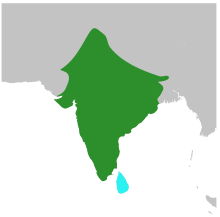White-browed wagtail
| White-browed wagtail | |
|---|---|
 |
|
| Scientific classification | |
| Kingdom: | Animalia |
| Phylum: | Chordata |
| Class: | Aves |
| Order: | Passeriformes |
| Family: | Motacillidae |
| Genus: | Motacilla |
| Species: | M. maderaspatensis |
| Binomial name | |
|
Motacilla maderaspatensis Gmelin, 1789 |
|
 |
|
| Synonyms | |
|
Motacilla madaraspatensis lapsus |
|
Motacilla madaraspatensis lapsus
Motacilla lugubris maderaspatensis
Motacilla picata
Motacilla maderaspatana
Motacilla maderas
The white-browed wagtail or large pied wagtail (Motacilla maderaspatensis) is a medium-sized bird and is the largest member of the wagtail family. They are conspicuously patterned with black above and white below, a prominent white brow, shoulder stripe and outer tail feathers. They are common in small water bodies and have adapted to urban environments where they often nest on roof tops. The specific name is derived from the Indian city of Madras (now Chennai).
The white-browed wagtail is the largest species of wagtail at 21 cm length. It is a slender bird, with the characteristic long, constantly wagging tail of its genus. It has black upperparts, head and breast, with a white supercilium and large white wingbar. Unlike white wagtails it never has white on the forehead. The rest of the underparts are white. The female has the black less intense than in the male. Juveniles are like the females brown-grey where the adult is black.
The white-browed wagtail is a resident breeder in India and is endemic to the Indian subcontinent. It is found south of the Himalayas, east of the Indus system and to the west of Bangladesh. It is rare in the higher altitude regions but has been seen in Ladakh on the edge of the Tibetan plateau. In most of India it is found below 1000 m but in southern India it goes up into the hills up to 2200 m. It is very rare in the Indus valley area. It is absent from the Sind region of Pakistan. It is found in open freshwater wetland habitats. It is one of the few Motacilla wagtails that has adapted well to urban habitats and is often found perched on overhead water storages in residential buildings.
It is a rare winter visitor to Sri Lanka and have possibly extended their range in recent times.
Stuart Baker in his second edition of The Fauna of British India considered this as a subspecies of the white wagtail, calling it Motacilla lugubris maderaspatensis. This was however criticized by C B Ticehurst, who noted that it was much larger, never had the white forehead of the white wagtail, was non-migratory and lacked a spring moult. This species is now considered to form a superspecies with Japanese wagtail, Mekong wagtail and the more distant African pied wagtail. Similarities in pre-copulatory behaviour with the Japanese wagtail have been noted. Its song much resembles that of the recently described Mekong wagtail. mtDNA and NADH dehydrogenase subunit 2 sequence data has not been able to robustly resolve the relationships of these birds, especially in respect to the blue-headed wagtail and its relatives.
...
Wikipedia

